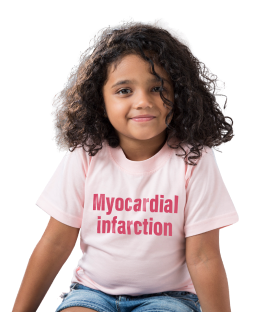Left untreated, HoFH can progress quickly and lead to premature cardiovascular events and mortality1–9

The progression of HoFH
At Birth
Markedly elevated LDL-C levels1
Reported LDL-C levels as high as 13.2 mmol/L (in a fetus)3 and 18.25 mmol/L (in a neonate)4
Childhood
Deposits of cholesterol in skin, tendons, and vasculature begin to develop1
Valvular cholesterol accumulates, leading to aortic stenosis and regurgitation1
Patients with severe phenotypes may experience an MI before their 10th year5-10
Adolescence
First major cardiovascular events in patients with a less severe phenotype1
Cholesterol and calcium deposits continue to develop1
Worsening fibrosis and inflammation in aortic root and aortic valve cusps can lead to supravalvular aortic stenosis1
Adulthood
Atherosclerosis and coronary artery disease progress1
Severe aortic calcification1
Heart failure, sudden cardiac death1
Poor prognosis despite available treatments2
If untreated, patients with the most severe phenotype rarely survive beyond 30 years1

MI, myocardial infarction.
The burden of HoFH
HoFH represents a considerable burden for patients due to physical signs and limitations caused by the disease, as well as a number of psychosocial factors1,2
Visible signs, physical limitations, and emotional distress due to effects of cholesterol deposition1,2
- Symptoms such as fatigue and shortness of breath may limit physical activity
- Potentially unsightly, painful, or even disabling cutaneous cholesterol deposition (xanthomas)
Psychosocial functioning1
Patients reported feeling ashamed of their condition, being emotionally isolated, and having uncertainty about disease progression
Impact on family and social activity1
Patients reported being unable to participate in social and sporting activities
References
1. Cuchel M et al. Eur Heart J. 2014;35:2146–2157; 2. Bruckert E. Atheroscler Suppl. 2014;15:26–32; 3. de Gennes JL et al. Arteriosclerosis. 1985;5:440–442; 4. Patsch W et al. J Clin Invest. 1980;66:123–129; 5. Al-Shaikh AM et al. Cardiol Young. 2002;12:105–112. 6. Naoumova RP et al. Curr Opin Lipidol. 2004;15:413–422; 7. Raal FJ et al. Atherosclerosis. 2018;277:483–492; 8. Widhalm K et al. J Pediatr. 2011;158:167; 9. Widhalm K et al. Atherosclerosis. 2017;257:86–89;